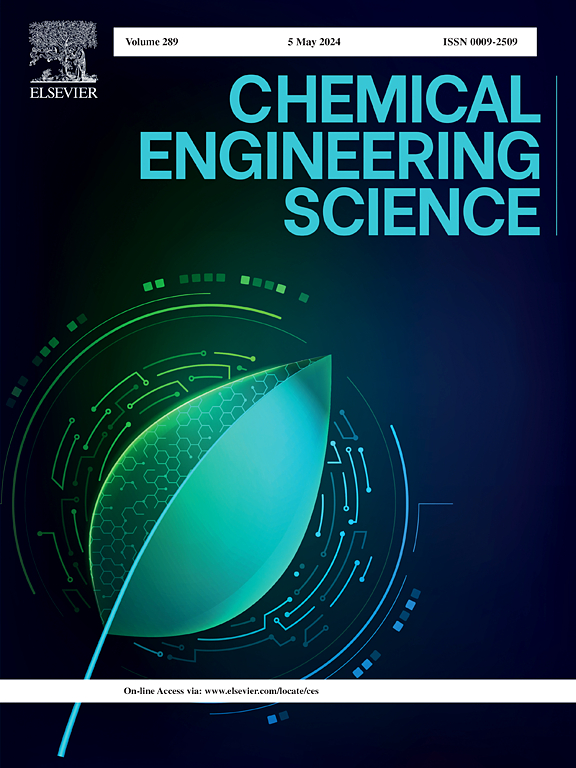原位MgO工程枝状纤维纳米二氧化硅作为大气压力下固定CO2的有效催化剂
IF 4.1
2区 工程技术
Q2 ENGINEERING, CHEMICAL
引用次数: 0
摘要
利用二氧化碳(CO2)合成增值化学品被广泛认为是减缓全球变暖和促进环境可持续性的可持续战略。在这项研究中,我们设计了一种原位氧化镁取代工程树枝状纤维纳米二氧化硅(MgO@DFNS)催化剂,用于在常压下将二氧化碳化学固定为环状碳酸盐。采用简单的一锅水热法合成了一系列不同MgO负荷量(X wt.% MgO@DFNS)的催化剂。利用先进的各种分析和光谱技术对合成材料的结构和物理化学性质进行了全面表征。特别地,通过Rietveld细化和理论模拟研究了它们的微观结构和弹性性能。为了评价催化性能,筛选了MgO@DFNS催化剂,用于在120 °C常压下6 h将CO2和氧化苯乙烯转化为碳酸苯乙烯。在所测试的催化剂中,10 wt% MgO@DFNS的催化活性最高,对苯乙烯的转化率为96 %,对苯乙烯的选择性为92 %。系统优化了催化剂用量、碱用量、反应温度、反应时间等反应参数。在此优化条件下,该催化剂具有广泛的底物范围,在各种环氧化物中具有良好到优异的产率。值得注意的是,优异的催化性能归功于MgO@DFNS催化剂的固有特性,包括高热稳定性、大比表面积、合适的孔径分布、独特的褶皱径向形态和高密度的活性位点。此外,该催化剂表现出优异的可回收性,在连续六个反应周期中保持其结构和物理化学完整性。前期报道的硅基催化剂与本文的工作有较好的相关性。通过表征和MgO@DFNS表面催化的实验结果,提出了CO2固定过程的合理反应机理。本文章由计算机程序翻译,如有差异,请以英文原文为准。

In-Situ MgO engineered dendritic fibrous nano silica as an efficient catalyst for fixation of CO2 at atmospheric pressure
The utilization of carbon dioxide (CO2) for the synthesis of value-added chemicals is widely recognized as a sustainable strategy to mitigate global warming and promote environmental sustainability. In this study, we have designed an in-situ magnesium oxide substituted engineered dendritic fibrous nanosilica (MgO@DFNS) catalyst for the chemical fixation of CO2 into cyclic carbonates under atmospheric pressure. A series of catalysts with varying MgO loadings (X wt.% MgO@DFNS) were synthesized via a simple, one-pot hydrothermal method. The structural and physicochemical properties of the synthesized materials were comprehensively characterized using advanced various analytical and spectroscopic techniques. In particular, their microstructural and elastic properties were examined through Rietveld refinement and theoretical simulations. To evaluate catalytic performance, MgO@DFNS catalysts were screened for the conversion of CO2 and styrene oxide into styrene carbonate at 120 °C for 6 h under atmospheric pressure. Among the tested catalysts, the 10 wt% MgO@DFNS demonstrated the highest catalytic activity, achieving 96 % conversion of styrene oxide with 92 % selectivity toward styrene carbonate. Reaction parameters such as catalyst dosage, base amount, temperature, and reaction time were systematically optimized. Under these optimized conditions, the catalyst also exhibited broad substrate scope with good to excellent product yields across various epoxides. Notably, the superior catalytic performance is attributed to the inherent properties of the MgO@DFNS catalyst, including high thermal stability, large specific surface area, appropriate pore size distribution, unique wrinkled radial morphology, and a high density of active sites. Furthermore, the catalyst demonstrated excellent recyclability, maintaining its structural and physicochemical integrity over six consecutive reaction cycles. The earlier reported silica-based catalysts were well correlated with the present work in detail. A plausible reaction mechanism for the CO2 fixation process was proposed supported by characterization and experimental results catalyzed by MgO@DFNS surface.
求助全文
通过发布文献求助,成功后即可免费获取论文全文。
去求助
来源期刊

Chemical Engineering Science
工程技术-工程:化工
CiteScore
7.50
自引率
8.50%
发文量
1025
审稿时长
50 days
期刊介绍:
Chemical engineering enables the transformation of natural resources and energy into useful products for society. It draws on and applies natural sciences, mathematics and economics, and has developed fundamental engineering science that underpins the discipline.
Chemical Engineering Science (CES) has been publishing papers on the fundamentals of chemical engineering since 1951. CES is the platform where the most significant advances in the discipline have ever since been published. Chemical Engineering Science has accompanied and sustained chemical engineering through its development into the vibrant and broad scientific discipline it is today.
 求助内容:
求助内容: 应助结果提醒方式:
应助结果提醒方式:


